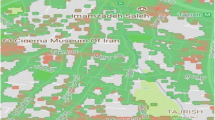Abstract
With the next generation of mobile networks closing in, its main characteristics have already been proposed and adapted. Ultra-dense heterogeneous networks seem to be one of the main drivers to answer the need for larger device connectivity and increased data rate. Multiple Base Stations with different specifications will be deployed to achieve these targets. Femtocells are a type of Base Station that is expected to dominate, due to their low cost and easy deployment and maintenance. However, trying to increase spectral efficiency with the use of femtocells, by multiple base stations utilizing the same spectrum will lead to severe interference phenomena. This can be tackled by sharing spectrum strategies and power control techniques. In this manuscript, we propose a full scheme of resource management that can be applied in instances of femtocell deployments of increased density. The mechanism is based on coordination among the femtocells to achieve better spectrum usage, on power control and on hybrid access configuration aiming to fairness in resource allocation and to the improvement of overall capacity. Conducted simulations showed that our algorithm increases the overall capacity, protects non-subscribed users and balances the hybrid access effect on subscribers.








Similar content being viewed by others
References
Osseiran, A., Boccardi, F., Braun, V., Kusume, K., Marsch, P., Maternia, M., et al. (2014). Scenarios for 5G mobile and wireless communications: The vision of the METIS project. IEEE Communications Magazine, 52(5), 26–35.
Yavuz, M., Meshkati, F., Nanda, S., Pokhariyal, A., Johnson, N., Roghothaman, B., et al. (2009). Interference management and performance analysis of umts/hspa + femtocells. IEEE Communications Magazine, 47(9), 102–109.
Jacob, P., & Madhukumar, A. S. (2015). Handling interference in self-organizing femtocell networks through frequency-polarization diversity. Wireless Networks, 22(2), 383–401.
Cho, K.-T., & Ryu, B. H. (2012). Partitioning resource priority regions for hybrid access mode femtocells. In 2012 IEEE 23rd international symposium on personal indoor and mobile radio communications (PIMRC) (pp. 625–630).
Bernal-Mor, E., Pla, V., Gutierrez-Estevez, D., & Martinez-Bauset, J. (2012). Resource management for macrocell users in hybrid access femtocells. In Global communications conference (GLOBECOM), 2012 IEEE (pp. 1859–1864).
Zhong, Y., & Zhang, W. (2013). Multi-channel hybrid access femtocells: A stochastic geometric analysis. IEEE Transactions on Communications, 61(7), 3016–3026.
Ahmed, A. U., Islam, M. T., Ismail, M., & Ghanbarisabagh, M. (2014). Dynamic resource allocation in hybrid access femtocell network. The Scientific World Journal, 2014, 7. Article ID 539720.
Chen, Y., Zhang, J., & Zhang, Q. (2013). Incentive mechanism for hybrid access in femtocell network with traffic uncertainty. In 2013 IEEE international conference on communications (ICC) (pp. 6333–6337).
Chai, C.-H., Shih, Y.-Y., & Pang, A.-C. (2013). A spectrum-sharing rewarding framework for co-channel hybrid access femtocell networks. In INFOCOM, 2013 Proceedings IEEE (pp. 565–569).
Lalam, M., Lestable, T., & Maqbool, M. (2013). Centralised power setting for femtocell cluster. In 2013 IEEE Globecom workshops (GC Wkshps) (pp. 795–800). doi:10.1109/GLOCOMW.2013.6825086.
Oh, D. C., Lee, H. C., & Lee, Y. H. (2011). Power control and beamforming for femtocells in the presence of channel uncertainty. IEEE Transactions on Vehicular Technology, 60(6), 2545–2554. doi:10.1109/TVT.2011.2158615.
Han, Q., Ma, K., Wang, X., Guan, X., & Ma, J. (2013). Stackelberg game based interference management for two-tier femtocell networks. Wireless Networks, 19(7), 1665–1677. doi:10.1007/s11276-013-0562-4.
Wang, X., Zheng, W., Lu, Z., Wen, X., & Li, W. (2014). Dense femtocell networks power self-optimization: An exact potential game approach. International Journal of Communication Systems. doi:10.1002/dac.2788.
Estrada, R., Jarray, A., Otrok, H., & Dziong, Z. (2013). Base station selection and resource allocation in macro–femtocell networks under noisy scenario. Wireless Networks, 20(1), 115–131. doi:10.1007/s11276-013-0594-9.
Lei, H., Zhang, L., Zhang, X., & Yang, D. (2007). A novel multi-cell OFDMA system structure using fractional frequency reuse. In IEEE 18th international symposium on personal, indoor and mobile radio communications, 2007. PIMRC 2007 (pp. 1–5).
Claussen, H. (2007). Performance of macro- and co-channel femtocells in a hierarchical cell structure. In IEEE 18th international symposium on personal indoor and mobile radio communications, 2007. PIMRC 2007 (pp. 1–5).
GPP TR 36.814 V9.0.0, Evolved Universal Terrestrial Radio Access (E-UTRA): Further advancements for E-UTRA physical layer aspects (Release 9). 3rd Generation Partnership Project, Technical Report (2010).
Lee, P., Lee, T., Jeong, J., & Shin, J. (2010). Interference management in LTE femtocell systems using fractional frequency reuse. In 12th International conference on advanced communication technology 2010 (ICACT’10) (Vol. 2, pp. 1047–1051).
Simsek, M., Akbudak, T., Zhao, B., & Czylwik, A. (2010). An LTE-femtocell dynamic system level simulator. In 2010 International ITG workshop on smart antennas (WSA) (pp. 66–71).
GPP TS 36.133, Requirements for support of radio resource management.
GPP TR 36.300, Evolved universal terrestrial radio access (EUTRA) and evolved universal terrestrial radio access network (EUTRAN); overall description.
Herranz, C., Osa, V., Monserrat, J. F., Calabuig, D., Cardona, N., & Gelabert, X. (2012). Cognitive radio enabling opportunistic spectrum access in LTE-Advanced femtocells. In 2012 IEEE international conference on communications (ICC), Ottawa, ON (pp. 5593–5597).
Author information
Authors and Affiliations
Corresponding author
Rights and permissions
About this article
Cite this article
Bouras, C., Diles, G. Interference Management Strategy for 5G Femtocell Clusters. Wireless Pers Commun 96, 323–339 (2017). https://doi.org/10.1007/s11277-017-4169-4
Published:
Issue Date:
DOI: https://doi.org/10.1007/s11277-017-4169-4




